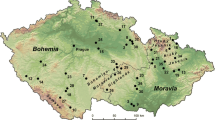Summary
During the months January and February 1990 a series of severe cyclones were responsible for enormous wind-induced damage in Europe. The final of this series, on 27 February 1990, cyclone “Vivian” mainly affected the alpine valleys of Switzerland. 5 Millions m3 of timber were felled by the severe winds, a record number in this century. A complete damage survey of the deforested areas offers in combination with meteorological data an unique data set for a detailed case study of this extreme event.
This paper describes the general meteorological development from the synoptic scale down to the mesoscale of Switzerland and presents a general overview of the damage situation. The main results show that a rare situation of a straight frontal zone stretching over the whole Atlantic Ocean and showing a strong gradient in temperature pointed directly toward Central-Europe. Two waves formed along this elongated polar front and deepend rapidly to depressions. The first low travelled on the southernmost trajectory of the whole storm series and affected Switzerland most. North of the Alps the prefrontal warm air was blocked to the east by the arriving coldfront and had to escape into the complex terrain of the alpine valleys. There, the stormy winds were strengthened by channelizing and “Föhn” effects. The large temperature gradient between the prefrontal and the incoming air masses induced thunderstorm activity which vortices and downdrafts might have enhanced locally. As a result most of the damaged forested areas were found between 1200 and 1600 m MSL on slopes, which were mainly exposed toward the prevailing NW-winds. A comparison of extreme wind speeds for the period 1978–1992 revealed that this event's extreme high speed of 74.5 m/s, measured at a high elevated pass station in the mountains, was exceptional. For lower elevated stations the wind speeds were high but in the range of other observed extreme values. In addition to the severe wind forces the duration of sustained high wind speed was exceptionally long during February 1990.
Similar content being viewed by others
References
Burt, S. D., Mansfield, D. A., 1988: The great storm of 15–16 October 1987.Weather 43, 90–108.
Buwal, 1990: Sanasilva-Waldschadenbericht 1990. WSL (Eidg.Forschungsanstalt für Wald, Schnee und Landschaft), 8903 Birmensdorf, 29pp.
Franzen, L. G., 1991: The changing frequency of gales on the Swedish west coast and its possible relation to the increased damage to coniferous forests of southern Sweden.Int. J. Climatol. 11, 769–793.
Fujita, T. T., 1978: Manual of downburst identification for Project Nimrod. Satellite and Mesometeorology Research Project, SMRP Research Paper No. 156, Dept. of the Geophysical Sciences, University of Chicago, 104pp.
Golden, J. H., 1991: Mitigation against extreme windstorms.Rev. Geophys. 29, 477–504.
Geipel, R., 1992:Naturrisiken, Katastrophenbewältigung im sozialen Umfeld. Darmstadt: Wissenschaftl. Buchgesellschaft, 229pp.
Hagen, M., 1992: On the appearance of a cold front with a narrow rainband in the vicinity of the Alps.Meteorol. Atmos. Phys. 48, 231–248.
Hammond, J. M., 1990: Storm in a teacup or winds of change?Weather 45, 443–449.
Joss, J., Waldvogel, A., 1990: Precipitation measurement and hydrology. In: Atlas, D. (ed.)Radar in Meteorology. Boston:Amer. Meteor. Soc. 577–606.
Li, L., Huntrieser, H., Schmid, W., 1992: Orographic impacts on a winter storm. 22nd Conf. on Alpine Meteorology, ITAM92, Toulouse, France, 177–181.
McCallum, 1990: The burn's day storm, 25 January 1990.Weather 45, 166–173.
Münchener Rück, 1993: Winterstürme in Europa — Schadenanalyse 1990 — Schadenpotentiale. Münchener Rückversicherungs-Gesellschaft, 55pp.
Rottmann, M., 1986: Wind- und Sturmschäden im Wald. Beiträge zur Beurteilung der Bruchgefährdung, zur Schadensvorbeugung und zur Behandlung sturmgeschädigter Nadelholzbestände. Frankfurt a.M.: Sauerländer's Verlag, 128pp.
Schweizer Rück, 1985: Sturm in Europa: Schäden und Szenarien. Schweizerische Rückversicherungs-Gesellschaft, 43pp.
Scherrer, H. U., Gautschi, H., Hauenstein, P., 1990: Flächendeckende Waldzustandserfassung mit Infrarot-Luftbildern. Ber. Eidgenöss. Forsch.anst. Wald Schnee Landschaft, No. 318, 101pp.
Scherrer, H. U., 1993: Projekt zur flächenhaften Erfassung und Auswertung von Sturmschäden.Allg. Forst. Zeitschrift 48, 712–714.
Schmid, W., Högl, D., Syed, N., Waldvogel, A., 1990: A new Doppler radar for studies in alpine precipitation. 21th Int. Meeting on Alpine Meteorology, ITAM90, Engelberg, Switzerland, Swiss Meteor. Institute, 49–52.
Schmidtke, H., 1993: Die fraktale Geometrie von Sturmschadenflächen im Wald.Allg. Forst Zeitschrift 48, 710–712.
Schraft, A., Durand, E., Hausmann, P., 1993: Stürme über Europa, Schäden und Szenarien. Schweiz. Rückversicherungs-Gesellschaft, 28pp.
Author information
Authors and Affiliations
Additional information
With 16 Figures
Rights and permissions
About this article
Cite this article
Schüepp, M., Schiesser, H.H., Huntrieser, H. et al. The winterstorm “Vivian” of 27 February 1990: About the meteorological development, wind forces and damage situation in the forests of Switzerland. Theor Appl Climatol 49, 183–200 (1994). https://doi.org/10.1007/BF00865533
Received:
Issue Date:
DOI: https://doi.org/10.1007/BF00865533




